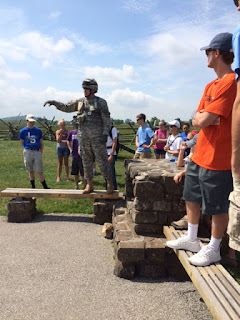History classes tour Gettysburg battlefield with Mr. Schreckengost
 |
| Maj. Gary Schreckengost describes the scene on Gettysburg's third day to AP US History and Local History students |
On May 27, the A.P. U.S. History and Local History classes took a
tour of the Gettysburg battlefield, just a short ride west in Adams County.
There they were treated to a review of that battle’s third day by Mr. Schreckengost of the middle school, in full camouflage and complete command. Schreckengost, a retired Major in the United States Army, and current eighth grade social studies teacher and Civil War historian, led a detailed tour of the portion of the battlefield held by the 69th Pennsylvania near the Angle, the view of Cemetery Ridge from the Virginia monument, and a short tour of the backside of Big Round Top before thunderstorms sent them home.
Perhaps the most interesting event of the day was a re-enactment of Pickett’s Charge, conducted with some vigor by a portion of the class and great disinterest by everyone else.
There they were treated to a review of that battle’s third day by Mr. Schreckengost of the middle school, in full camouflage and complete command. Schreckengost, a retired Major in the United States Army, and current eighth grade social studies teacher and Civil War historian, led a detailed tour of the portion of the battlefield held by the 69th Pennsylvania near the Angle, the view of Cemetery Ridge from the Virginia monument, and a short tour of the backside of Big Round Top before thunderstorms sent them home.
Perhaps the most interesting event of the day was a re-enactment of Pickett’s Charge, conducted with some vigor by a portion of the class and great disinterest by everyone else.
However, it is just that disinterest that field trips of this
nature try to combat. Pickett’s Charge, launched by General Lee at the head of
the South’s Army of Northern Virginia, ended in a military disaster that sealed
the Confederacy’s fate and assured the Union success.
To be able to just walk that one mile of open field in short sleeves, without gear, in May instead of a July, is a vivid demonstration of just what our forefathers went through during the trying years of the Civil War, and gives a greater appreciation of what they endured for us.
To be able to just walk that one mile of open field in short sleeves, without gear, in May instead of a July, is a vivid demonstration of just what our forefathers went through during the trying years of the Civil War, and gives a greater appreciation of what they endured for us.
